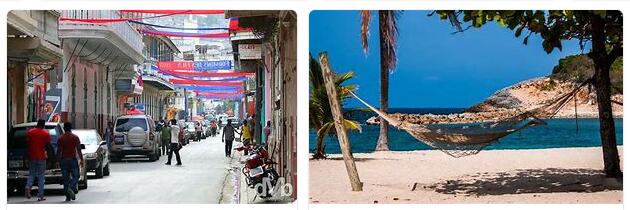Haiti is a republic in the west of the island of Hispaniola. Today’s residents are predominantly descendants of the slaves who were brought in from West Africa for plantation work in the 18th century. Mulattos live in the cities (around 10%). Coffee and cocoa are grown for export. In addition to tourism, industry is gaining in importance.
History: In 1697 Spain ceded the western third of the island of Hispaniola to France. The first republic in Latin America to become independent in 1804, the Dominican Republic split off from Haiti in 1844. In the 20th century Haiti was shaken by numerous civil wars, especially after the end of the Duvalier family’s dictatorship (1957–86). The domestic political situation in the country is marked by instability. In addition, Haiti has repeatedly experienced severe natural disasters in the past, which have set the country back in its development.
Geography
Climate
The marginal tropical climate with summer rainy season and winter dry season is differentiated by the relief design. On the windward side of the north-east trade wind, precipitation increases to over 5,000 mm per year and on the leeward side, especially in the depressions, falls to 600 mm (Cul-de-Sac plain). The temperatures fluctuate between 22 ° C and 28 ° C in the annual mean. By hurricanes often great damage. The resulting floods killed over 2,000 people in 2004 alone and left around 250,000 homeless. In 2008, four tropical cyclones hit Haiti in a row, killing several hundred people.
Vegetation
Except for the arid areas (succulents and thorn bushes), the original vegetation has been severely decimated by agricultural use and uncontrolled deforestation. Depending on the precipitation and altitude, it shows the change from evergreen rain and mountain forest to rain-green wet and dry forest, wet and dry savannah. Large-scale erosion damage restricts agricultural use. Forests only cover 3.5% of the country’s area.
Temperatures, precipitation, sunshine in Port-au-Prince (Haiti)
| Jan | Feb | March | Apr | May | Jun | Jul | Aug | Sep | Oct | Nov | Dec | |
| Daytime temperature | 31 ° C | 31 ° C | 32 ° C | 32 ° C | 33 ° C | 35 ° C | 35 ° C | 35 ° C | 34 ° C | 33 ° C | 32 ° C | 31 ° C |
| Night temperature | 23 ° C | 22 ° C | 22 ° C | 23 ° C | 23 ° C | 24 ° C | 25 ° C | 24 ° C | 24 ° C | 24 ° C | 23 ° C | 22 ° C |
| Water temperature | 27 ° C | 27 ° C | 27 ° C | 27 ° C | 28 ° C | 29 ° C | 29 ° C | 30 ° C | 30 ° C | 30 ° C | 29 ° C | 28 ° C |
| Precipitation in mm | 33 | 58 | 86 | 160 | 231 | 102 | 74 | 145 | 175 | 170 | 86 | 33 |
| Rainy days | 3 | 5 | 7 | 11 | 13 | 8 | 7 | 11 | 12 | 12 | 7 | 3 |
| Hours of sunshine | 9 | 9 | 9 | 9 | 8 | 8 | 9 | 9 | 8 | 8 | 8 | 8 |
| Sunrise | 6:25 | 6:15 | 7:00 | 6:35 | 6:15 | 6:10 | 6:20 | 6:30 | 6:35 | 6:45 | 5:55 | 6:15 |
| Sunset | 17:35 | 17:50 | 19:00 | 19:05 | 19:15 | 19:25 | 7:30 p.m. | 19:15 | 18:50 | 18:25 | 17:10 | 17:15 |
Temperatures
The annual average temperature in Port-au-Prince is 28 ° C. For comparison: Munich reaches an average of 8.6 ° C, in Berlin it is 9.6 ° C. The warmest month is June (30 ° C), coldest month of February with averages of 26.5 ° C. The maximum water temperature in Port-au-Prince is 30 ° C. Comfortable bathing is possible at these temperatures. All months have a water temperature of at least 21 ° C and are therefore suitable for a beach holiday.
Precipitation
The annual precipitation is 1353 mm on 99 days with precipitation. For comparison: In Munich, 967 mm, in Berlin 570 mm, precipitation is measured annually. The months of May and September are considered the rainy season, as more than 175 mm of precipitation can be expected per month. Overall, around 406 mm of precipitation can be expected in the rainy season. You cannot expect snow in any month in Port-au-Prince.
Sunshine
As our climate table shows, April is the sunniest month with an average of 9.1 hours of sunshine per day. On average over the year, the sun shines for 8.5 hours per day. For comparison: In Munich and Berlin, the sun shines an average of 4.7 hours per day throughout the year.
Cities nearby
The following larger towns are nearby and have a similar climate: Carrefour, Delmas 73, Pétionville, Delmas, Croix-des-Bouquets, Jacmel and Léogâne.
